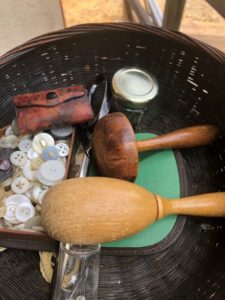Trolling the Smithsonian Institute (An Ode to the Past, Handsewing, and Repairs)
The Smithsonian was founded in 1846 “for the increase and diffusion of knowledge” and is
comprised of nineteen museums and the National Zoo. But many of the collections at the
Smithsonian Institute in Washington, DC are archived and are not viewable by the general
public. However, a lot of accessions are now available to be enjoyed online and so it is with hand sewing tools such as sewing birds.
Sewing Birds
Doesn’t “sewing bird” conjure up fanciful visions of industrious chickadees with tiny needles, darning elf socks? I am sorry to disappoint, but back in the day, hand-sewers in search of a third hand employed these clever, metal, bird-shaped clamps to hold fabric in their beak. The bird’s body was a pincushion and small scissors fitted into a slot. A strong, clever spring in the tail opened the bird’s beak and assured the user of a steady grip.
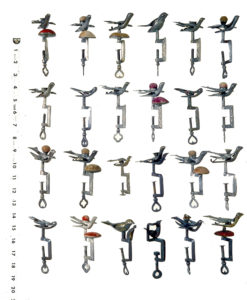
Sewing clamp. TE*T15758.000.
(Smithsonian Institute, sewing birds)
Patented in the 1850’s by Charles Waterman from Connecticut, sewing birds were touted to promote “health preserving properties to make sewing easier for the ladies,” presumably to improve their posture.
A fly-tying friend of mine uses a modern version with a built-in magnifier and I can think of any number of uses for a sewing bird clamped to my loom or worktable. Immediately, I think of hemming towels!
You can purchase sewing bird reproductions on Amazon, Wayfair, and Etsy at a modest price. If you are patient, you can find the real deal at estate sales and antique shops for $150-200.
Darning Eggs
Along with sewing birds, a darning egg used to be part of every sewist’s toolbox. Shaped like either a mushroom or an egg, these wooden tools allowed for easy darning of anything from socks to suit jackets. I was lucky enough to inherit my mom’s egg and mushroom and they lovingly reside in my grandma’s sewing basket.
(photo the author)
Slow-Fabric Garments Call for Loving Repairs
The Slow Food movement has recently given rise to a slow-garment movement. Instead of buying inexpensive clothing meant to be discarded after one season, the slow garment movement encourages us to go back to the way things were 70, 80, 100 years ago when fiber for clothing was grown and transformed into garments within the space of a few miles. This clothing was treasured, repaired, passed down and worn for many seasons.
Reweaving Woven Fabrics
While darning eggs and mushrooms are great for repairing knitted fabrics and some heavier woven fabrics, doing a repair on tropical weight wovens requires a different technique, called reweaving. This YouTube shows a highly skilled tailor employing the Kaketsugi method.
https://www.youtube.com/watch?v=haiA_4tBrjw Kaketsugi repair of woven fabrics
And here is another handy tool, known as Lancashire’s Smallest Loom, the Speedweve. Introduced to the UK in the 1940s by the Belarus immigrant Chesstok family, the Speedweve caught on quickly with wartime deprivations and clothing rationing. This little reweaving/darning loom was even included in the kit of WAAF women recruits. Concurrently in the US, Dritz introduced their Automatic Darner. Both tools were heavily used in the 1940s and 1950s, then looms fell out of use by the economic recovery of the 1960s. (Original Speedweve, JoyofSew.blog) 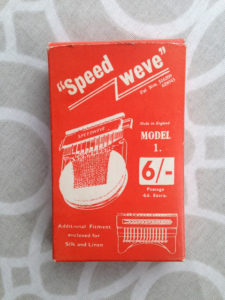
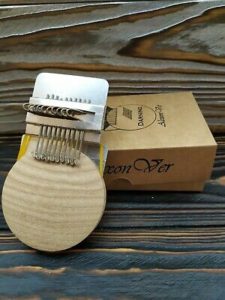 (Speedweve reproduction, eBay)
(Speedweve reproduction, eBay)
If you can score an original Speedweve out of grandma’s sewing box or find a reproduction, this is a handy YouTube tutorial https://youtu.be/etpqfr_LuEg
So instead of discarding, celebrate the garment’s life story. Rock those repairs – why hide them? Like each hard-earned wrinkle mellows on our face, every tear and worn spot on a garment adds to its biography. Honor those repairs in the Japanese Boro style with decorative running sashiko stitches, patch upon patch, year after year. This is a great YouTube on an interpretation of Boro style by Zoe Hong https://www.youtube.com/watch?v=XtpfQfd0J5M
(Cooper Hewitt Museum, Boro example)
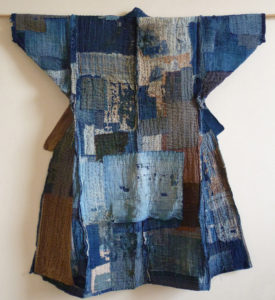
As fiber artists, we spend innumerable hours designing, spinning, weaving or knitting textiles – either bespoke or for our own use. As heartening as it is to see our products being used and worn (and worn out!) it is equally disheartening to see these goods discarded due to a worn heel or worn elbow. Let’s encourage our recipients to either repair these treasures themselves by including lengths of yarn or returning to the maker for repair. Share your stories of use and reuse with us.
